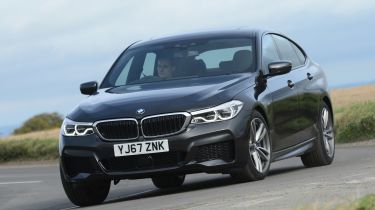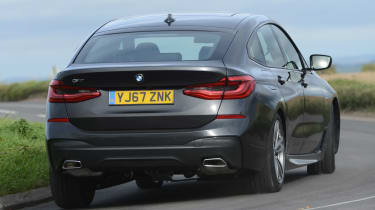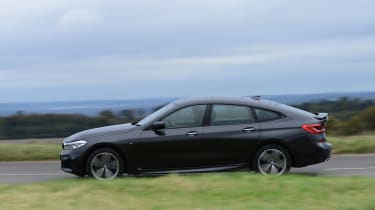New BMW 6 Series GT 2017 review
The new BMW 6 Series GT blends the dynamics of the 5 Series with the space of the 7 Series, but what's it like to drive?

By allowing its predecessor to grow, BMW’s all-new 6 Series GT is a more appealing alternative to the high-end executive car norm. It’s impressively spacious, remarkably comfortable and flawlessly built, but despite its claims, it can’t match the excellent 5 Series for driver appeal. It’s pricier, too, and the styling still won’t be to all tastes, while this 640i isn’t our pick of the range. The new car will continue to charm those after something a little more exclusive than a four-door saloon, but it’s unlikely to draw more buyers to the brand.
BMW bosses tell us its customers find “exclusivity and individuality” in models like the new 6 Series GT. Since 2008, the firm has sold more than one million of its supposedly ‘niche’ variants, with cars like the X4, X6 and 4 Series Gran Coupe heralding huge success across the globe.
But the outgoing 5 Series Gran Turismo has sold somewhat slower than its quirky cousins. Just 631 found homes in Britain last year – less than one per cent of the brand’s total UK output. With the brand’s latest platform underneath, a new look and a new identity, however, BMW hopes its 6 Series GT has what it takes to offer customers the difference they desire.
Used - available now

2022 MG
HS
12,807 milesAutomaticPetrol1.5L
Cash £16,287
2021 Citroen
C1
11,182 milesManualPetrol1.0L
Cash £9,487
2017 Vauxhall
Insignia
96,309 milesManualDiesel1.6L
Cash £4,500
2019 Land Rover
Range Rover Evoque
94,100 milesManualDiesel2.0L
Cash £8,750Said to blend the dynamics of a 5 Series saloon with the space and opulence of the larger 7 Series, BMW’s new 6 GT is an executive hatchback without much in the way of rivals. The firm will have its sights set on the soon-to-be-replaced Audi A7 and forthcoming Mercedes CLS as two key competitors, but BMW’s offering is an altogether different proposition.
Take a seat in the back and the 6 Series makes the outgoing Audi feel cramped and claustrophobic. Those stepping out of the old 5 GT will find it a more spacious place to be, too, as BMW has ditched the previous car’s theatre-style seating in favour of a lower rear bench. This allows for more headroom, while the longer wheelbase (now matching the latest 7 Series) means legroom is improved as well.
Buyers can also opt for adjustable backrests, which tilt electronically by up to six degrees for greater comfort on long journeys. Customers previously complained about the 5 GT’s compromised boot, too, so BMW has added an extra 110 litres (now 610 litres) with the rear seats in place and an additional 100 litres (up to 1,800 litres) with everything folded flat. That makes it slightly bigger even than a 5 Series Touring – though the sloping roof compromises versatility.
Up front, the high-set driving position feels quite different to what you’d find in a standard 5 Series, a trait which BMW claims makes it more comfortable on long distance drives. The dash design will be recognisable to those familiar with BMW’s latest executive saloon, albeit with slight corrections necessary to make it fit the wider body. Perceived quality is first rate, with our M Sport test car featuring intriguing open-pore fine wood, brushed metals and gloss plastics.
The feature-filled infotainment system has been lifted wholesale from the normal 5 Series, and can be operated via the 10.25-inch touchscreen or iDrive wheel, as well as by using the car’s voice or gesture control systems. All cars come with Professional Nav, a parking camera, a 20GB hard disk and Bluetooth connectivity. BMW’s Connected Drive services are also included.
While you’ll get used to that raised driving position, it doesn’t prevent the 6 GT from feeling like a big car from behind the wheel. And despite the new car being, on average, 115kg lighter than the model it replaces, it can’t match a 5 Series for agility.
There’s less crispness to the steering response and a little more body lean, even with our car’s optional variable dampers and standard rear air suspension. If you want a Gran Turismo that stays flat and level you can specify four-way air suspension with active roll stabilisation, but we’d argue that if you’re so dead set on sharp handling you’ll always be better off with a 5 Series.
The hushed six-cylinder engine in our 640i test car was impressively refined and punchy, too. It gets a touch course at higher revs, but the great slug of torque means you’ll rarely have to extend it that far. While it’s certainly fast, the 640i’s performance seems a little unnecessary given this car suits relaxed cruising more than spirited driving. It’s for that reason we’d instead recommend the 630d diesel, which offers more than enough real-world performance, is nearly as smooth, and is far more economical.
The plush Dakota leather seats are joyously opulent, seeming to offer more cushioning than the equivalent 5 Series, and come heated in the front as standard. Two-zone climate control is also included, while you can add the four-zone setup for £695.
BMW will offer a range of six-cylinder engines at launch, as well as a single four-cylinder 630i turbo petrol. There will be no 620d for the time being, despite BMW selling a similar unit in the old 5 GT. The most economical choice will be the 630d, then, which should do 55.3mpg.
Our flagship petrol will struggle to return 35mpg, while CO2 emissions of 187g/km puts it in the second highest company car Benefit in Kind tax band. All models apart from the 640i come with a choice of rear or all-wheel drive, though the flagship model is xDrive only.










